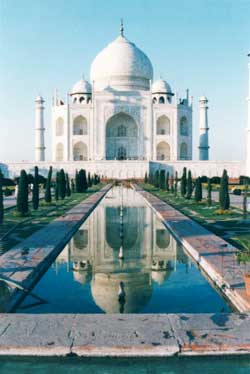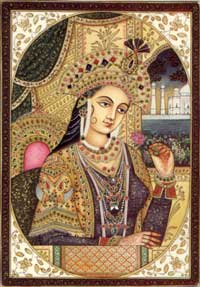Taj Mahal - Pearl of the Indian temple
 If Agra is a beautiful flower garden of Indian architecture art during the Mogol period, the Taj Mahal is not a castle or temple, but a tomb of the wife of Giahan Emperor - Empress Argiuman Bano Begum. At first, the mausoleum was named Tat Bibica Rauza, meaning the Queen's place of burial, later named the Taj Mahal, and Persian means the Crown of the Mogol.
If Agra is a beautiful flower garden of Indian architecture art during the Mogol period, the Taj Mahal is not a castle or temple, but a tomb of the wife of Giahan Emperor - Empress Argiuman Bano Begum. At first, the mausoleum was named Tat Bibica Rauza, meaning the Queen's place of burial, later named the Taj Mahal, and Persian means the Crown of the Mogol.
At 19, Agiuman Bano Begum became the second wife of Prince Guram (later Sac Giahan). Although she is the second wife, Begum is always the wife most loved by Prince Guram. In 1627, after Guram took the throne, taking the title of Gia Giahan (meaning lord of the world), Mumtaz also became Queen of India. However, the life of the two women suddenly broke. In the spring of 1636, Mumtaz fell ill and died. Before her death, the Queen asked Emperor Giahan to promise to build her a tomb worthy of their love and 19 years of cohabitation.
The death of a beloved wife makes Sac Giahan extremely miserable. He always embarks on building a tomb for his wife as he promised.
Immediately, the most famous builders were invited to Agra to formulate a project to build the Queen's tomb. Sac Giahan chose the project of the Indian architect Istat Han Effendi to follow the model of Tieu's tombs.

Queen Mumtaz
A huge construction army of 24,000 people was established. The most precious and colorful marble types are transferred from everywhere to Agra. In 1632, the construction at Taj Mahal was started. For 24 years, 24,000 workers worked hard and spent 40 million rupees.
Taj Mahal was built on a large rectangular area (580 m long, 304 m wide), with spectacular scenery, harmonious surroundings. The main architecture of the tomb is an octagonal castle, built of white marble and red sandstone on a very high platform. The horn of the blue sky was a massive, majestic white marble arch of 75 m high surrounded by four smaller round arches. At four corners, it reached four turrets up to 40 m high. In the tomb, there are many valleys carved with 12 precious stones, decorated in traditional Indian style.
In the middle of the large, bright room on the second floor are two pale pink marble coffins, decorated with floral patterns and rows of Arabic words drawn from the Koran. But in these coffins there is no remains of the deceased. The two coffins on the second floor only represent real coffins downstairs.
 According to the Islamic conception, from true coffins, the dead's soul flies up to the coffins on the upper floor, from there, to cross the roof of the roof to heaven, to the throne of Allah (Arabic script al - ilad). The remains of Mumtaz and Giahan are placed in two caskets downstairs.
According to the Islamic conception, from true coffins, the dead's soul flies up to the coffins on the upper floor, from there, to cross the roof of the roof to heaven, to the throne of Allah (Arabic script al - ilad). The remains of Mumtaz and Giahan are placed in two caskets downstairs.
Taj Mahal has indeed been created with the flesh and wisdom of the Indians and has become one of the masterpieces of the art of human architecture. Taj Mahal deserves the name of the Pearl of Indian temples or the First Dream of white stone.

- Taj Mahal - India
- 18 unexpected facts about Taj Mahal
- The beauty of the Taj Mahal before the marble pillar collapsed
- The sultry beauty of Taj Mahal is disappearing
- The Taj Mahal tomb turned yellow for an extremely ominous reason
- The specimen of the Sword Lake Turtle was brought to Ngoc Son Temple
- The reason for not drinking much pearl milk tea
- Vacuum pillar touches strange land in Indian temple
- Find the 8,000-year-old 'world's oldest' pearl
- Treasures of $ 22 billion in ancient Indian temples
- Mystery of temples 'timeless' in India: There is a value of up to 100 billion USD!
- Discover pearl secrets
 Norway built the world's tallest wooden tower
Norway built the world's tallest wooden tower Kremlin
Kremlin Ashurbanipal: The oldest royal library in the world
Ashurbanipal: The oldest royal library in the world Decoding the thousand-year construction of Qin Shihuang shocked the world
Decoding the thousand-year construction of Qin Shihuang shocked the world